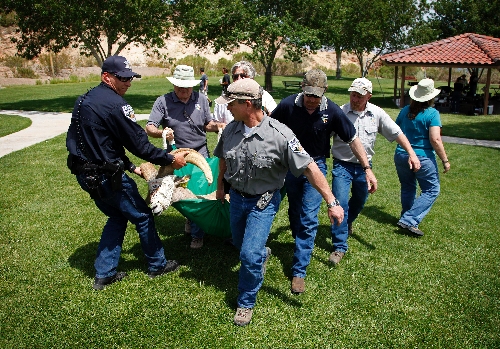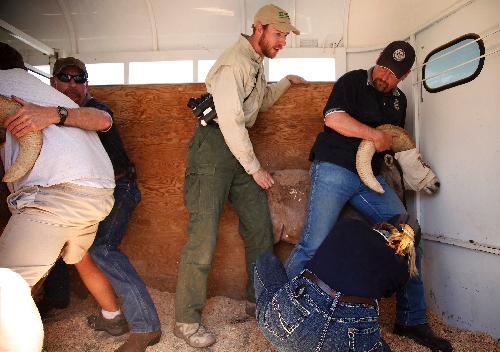Thriving Boulder City bighorn replenish other herds
When the drugs hit, the ram is standing at attention on a small hill near Hemenway Park in Boulder City.
First his head droops and turns to the side, as if one curled horn is suddenly heavier than the other. Then the 200-pound animal sways slightly on spindly legs, lowers himself to the ground and sags into unconsciousness.
The dart has done its work.
Within minutes, a team from the Nevada Department of Wildlife descends on the desert bighorn, pulling a hood over his eyes, binding his legs with leather straps and loading him into the bed of a pickup.
They haul him back to the park and lay him out on a folding table in the shade of a ramada, where he is evaluated and medicated for what comes next.
After four years of easy living, this ram is going on a trip.
REPAIRING THE DAMAGE
Bighorn sheep once roamed nearly every mountain range in Nevada. It took humans about a century to nearly wipe them out.
The decline began in the mid-1800s, as settlers and prospectors swept into the state, mostly in the north.
By 1960, unregulated hunting, habitat loss and disease spread by domestic livestock had reduced Nevada's bighorn population to about 1,200 animals in a handful of ranges, none of them north of Ely or west of Hawthorne.
Wildlife officials launched the Bighorn Sheep Release Program in 1967 to return the official state animal to its former glory.
Since then, bighorn sheep have been restored to more than 60 mountain ranges across Nevada. Their total population now tops 10,000 adults, more than any other state.
Wildlife biologist Pat Cummings said the program works for one simple reason: "It's because they belong there. They were in those mountains historically."
To ease the transition, wildlife officials release their transplants during daylight hours at or near a reliable source of water and forage.
Cummings said Nevada's bighorn program has become the envy of the West, as well as its supplier. In recent years, sheep from the Silver State have been shipped off to help restore herds in Utah, Colorado and Texas.
The River Mountains between Boulder City and Henderson serve as the cradle of life for the desert bighorn. Of the nearly 2,900 sheep captured and relocated over the past 45 years, more than 800 came from that particular herd.
During a three-day operation last week, 11 more rams were culled from the River Mountains and shipped 450 miles north to the Virginia Range, between Reno and Fernley.
There, they joined 25 ewes and lambs that were transplanted from the mountains near Tonopah last fall to replace a herd wiped out more than 100 years ago.
FRIDGE FULL OF FOOD
Hemenway Park is ground zero for bighorn sheep.
The River Mountains herd ranges in size from 200 to 250 adults, and roughly one-third of them graze in the park regularly. During the hottest six months of the year, they make their way down from the mountains on a daily basis.
"It's much easier living in the park than in the mountains, so they're kind of taking the path of least resistance," said Doug Nielsen, spokesman for the Department of Wildlife.
"It's kind of like having a 14-year-old kid with a refrigerator full of food. He's not going to want to get too far away from that thing."
The easy access to green grass and water shows in the health of the animals. Of the 11 rams removed from the park last week, several topped 200 pounds.
And they tend to be as productive as they are big, Cummings said.
"They're pumping lambs out left and right, which makes my life a nightmare," he said. "They're keeping pace with our ability to capture and translocate them."
AN EMOTIONAL RELEASE
Cummings hopes to start collecting sheep from the River Mountains several times a year - rams in the spring, ewes and lambs in the fall.
But there will still be plenty of sheep in Hemenway Park, he said.
That's good news in Boulder City, where the community largely embraces the herd and the tourist traffic it brings.
City Parks and Recreation Director Roger Hall said the sheep even help keep the grass trimmed. "And they fertilize," he said.
Cummings said they went after rams this time around to help correct a gender imbalance created in part by previous roundups targeting ewes and lambs.
"Things can get out of control" when too many males are around, he said. Overly aggressive rams have been known to chase ewes out into traffic on nearby U.S. Highway 93.
"This herd is basically surrounded by suburban development and roads," he said.
Cummings caught his first desert bighorn in 1987, when he was a college intern with NDOW.
Now he organizes the captures, sweating over every detail from the initial setup to that emotional moment when the animals are set free in their new homes.
"It's a feeling that is indescribable. When that last sheep gets out of the trailer ..." said Cummings, trailing off as his eyes filled with tears.
READY TO TRAVEL
In the span of 10 minutes, the ram is weighed, measured, shot full of medicine and affixed with a bright yellow ear tag.
He also gets his teeth checked, his blood drawn and his ears cleared of ticks while one member of the team administers oxygen through a tube stuck in his nose.
Bighorn sheep in Nevada are generally captured in one of three ways: snared with nets fired from helicopters, lured with bait and then netted, or darted.
The dart method doesn't see as much use because it requires capture crews to wait around somewhere sheep regularly congregate.
The ram on the table wandered into the park late Wednesday morning to graze with a group of nine other males. He was shot from the open door of a pickup parked less than 20 yards away.
Peregrine Wolff, the state wildlife veterinarian who cares for sheep during captures, said the dart that hit him in the left flank was filled with a three-drug cocktail known by the acronym BAM.
It generally takes between 7 and 15 minutes to bring a bighorn down, she said.
Once the examination is over, the ram is carried to a modified horse trailer where his hood and leg restraints are removed.
Then Wolff injects him with a reversing agent to wake him up and a dose of a human anti-psychotic drug to keep him calm during his long ride north.
When the drugs hit, the groggy ram lifts his head and sniffs the air.
Outside the trailer, sheep keep streaming into the park to graze.
Contact reporter Henry Brean at hbrean@reviewjournal.com or 702-383-0350.



















